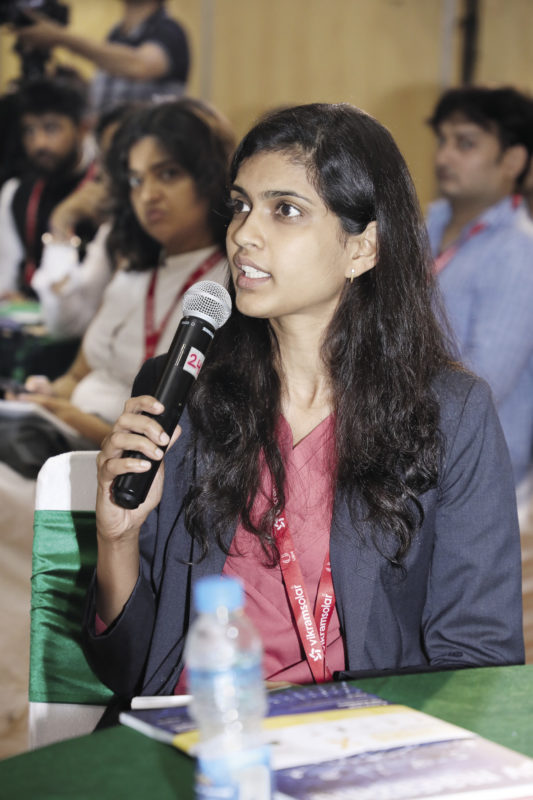
Image: pv magazine
pv magazine: Floating PV installations have been identified as a potential growth area for India’s solar industry in the future. Why is it that there is such potential for floating installations in India?
Surbhi Singhvi: Floating solar is a very exciting application for India. Limited availability of land, as well as issues faced in land acquisition, are major drivers behind its increasing popularity. Other factors include optimum utilization of existing grid infrastructure and a higher power generation potential as compared to ground-mounted systems.
What are your expectations for floating PV installations in the coming years?
India has already made good initial progress with around 200 MW of floating solar projects under development and around 1.3 GW of tender issuance. We expect new installations at 1 GW to 2 GW every year.
What are some of the limitations to floating PV installations in India?
It is still a relatively new concept with high learning for policy makers, investors and contractors. Technical issues including site surveys, engineering design and quality need to be tackled. While floats take most of the limelight in discussions, equally important is the design of anchoring and mooring systems, that greatly differs across water bodies, depending on various characteristics. The need for extensive customization for different water bodies also adds time and cost to the installations. Relevant quality standards need to be developed to ensure optimal performance, as well as no adverse impact on marine environments.
The higher system costs of floating solar installations – 20-25% more expensive than ground-mounted projects – is also a limitation. We expect greater scale, design innovation and mobile manufacturing of floats to address this issue over time.
Future PV Roundtable at Renewable Energy India Expo 2019
Floating PV installations and the outlook for battery storage will be up for discussion at the pv magazine Future PV Roundtable event at REI this year. The event will take place as a part of the REI conference program from 2:00 p.m. – 3:30 p.m. on Sept. 19. For more information, and to register visit: https://www.pv-magazine.com/pv-magazine-events/future-pv-roundtable-renewable-energy-india-expo-2019/
This content is protected by copyright and may not be reused. If you want to cooperate with us and would like to reuse some of our content, please contact: editors@pv-magazine.com.
On-grid energy storage deployment is also a nascent market segment. What are the potential use/business cases for utility-scale storage in India?
Yes, it remains a nascent market segment in India, the growth of which largely hinges on appropriate government policy and regulatory support. A pick-up in tender activity indicates the growth potential. Until now, more than 100 MWh of storage tenders have been issued.
Energy storage can assist the energy transition by supporting the growth of large-scale intermittent renewable energy in India. It presents multiple use cases for grid operators, developers and end consumers, including peak load management, RE smoothing, higher system reliability, frequency regulation and reduction in transmission infrastructure capex.
And for C&I or residential installations? Is it true that brownouts or power outages might present an opportunity for energy storage?
Behind-the-meter energy storage presents an attractive market opportunity in the C&I and residential market. Applications include savings through load management, power quality maintenance, diesel abatement and power backup, among others.
Especially for C&I consumers, power outages even for a short while can cause serious business disruption and have a significant cost. In India, power outages are still a prevalent issue in cities and industrial clusters. Most of these establishments currently use diesel gensets for power backup.
The residential segment has already been a large market for home inverters and UPS systems. With technological advancements in lithium-ion, people are expected to replace existing lead-acid batteries with lithium-ion ones. Moreover, increasing rooftop solar capacity and policies moving away from net metering are also likely to enhance adoption of longer duration storage systems.
EVs and other e-mobility products could potentially assist with air pollution in India’s cities. How would you characterize the level of deployment?
The transport sector is a significant contributor to urban air pollution in India. EVs hold a lot pf promise but the deployment is expected to be too small to make any material difference over the next five years at least.
We expect the government to focus on public transport and fleet vehicles, which would be more efficient from a capital perspective. With high growth in renewable energy in India, pollution levels at point of source are also expected to abate over time.
Electric vehicle chargers, if deployment increases, could present an opportunity for power electronics manufacturers. How much activity is going on in this space? Is it a sizable opportunity?
There is a lot of interest among power companies for setting up charging infrastructure. At present, it is a very small market, but pilot programs are being initiated by both public and private sector entities. Growth depends on a number of factors besides uptake of EVs – the development of standard charging protocols, appropriate business models, technology advancements, and cost of infrastructure. It is also encouraging to see that the Indian government has set aside 10% of total funding under its latest policy announcement for EVs (FAME-II), equivalent to INR 10 billion ($140 million), specifically for the development of charging infrastructure.
By Jonathan Gifford
This content is protected by copyright and may not be reused. If you want to cooperate with us and would like to reuse some of our content, please contact: editors@pv-magazine.com.








By submitting this form you agree to pv magazine using your data for the purposes of publishing your comment.
Your personal data will only be disclosed or otherwise transmitted to third parties for the purposes of spam filtering or if this is necessary for technical maintenance of the website. Any other transfer to third parties will not take place unless this is justified on the basis of applicable data protection regulations or if pv magazine is legally obliged to do so.
You may revoke this consent at any time with effect for the future, in which case your personal data will be deleted immediately. Otherwise, your data will be deleted if pv magazine has processed your request or the purpose of data storage is fulfilled.
Further information on data privacy can be found in our Data Protection Policy.